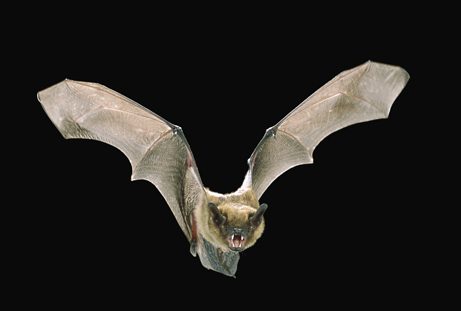
When the sound of a bag of potato chips is being torn open by someone, the noise cuts through a darkened movie theater. The noise, in an otherwise silent space, pinpoints for all moviegoers exactly where the chips are being eaten. According to a new Tel Aviv University (TAU) study, bats operate in a similar fashion.
Bats, hunting at night in groups, improve their chances of finding the best patches of insects by engaging in reciprocal eavesdropping, says the study's lead investigator, Dr. Yossi Yovel of TAU's Department of Zoology. "Bats emit sonar signals to sense their environment. By recording them in real time, we can tell when they're attacking prey or when they encounter another bat and how they respond to it. This reveals new knowledge on the world of these miniature flying mammals, which account for more than 20 percent of mammalian species. It is an example of how an animal gains from working in a group, and it could even provide insight into operating swarms of drones in a collective search mission, for example."
The research, published recently in the journal Current Biology, was conducted in part by TAU graduate students Noam Cvikel, Katya Egert-Berg, and post-doc Eran Levin.
The subject of the study, the Rhinopoma microphyllum, also known as the greater mouse-tailed bat, preys on flying queen ants, an insect that congregates in highly-dispersed patches that can be difficult to find. While bats are able to use biosonar to detect their prey within 33 feet, their remarkable "eavesdropping" honing radar is able to identify other bats eating that prey from some 328 feet away. The study, conducted over two summers (2012-13) in Israel's northern Galilee region, found that bats' unique ability to snoop on others' hunting improved their collective chance of feeding well.
For the purpose of the study, Dr. Yovel and his team rigged 30 greater mouse-tailed bats, a highly social species of bats that migrate to Israel for the summer, with very small, GPS-enabled ultrasonic recorders. The chips were attached with surgical glue which wore off after a week, causing them to fall off the bats. The team collected these chips to analyze the data they contained. They were only able to retrieve 40 per cent of the recorders, but they contained valuable recordings of 1,100 bat interactions, allowing the researchers to identify when the bats were hunting down prey and when they were simply chatting with other bats.
"The high bat density might result in a few possible sources of interference," said Dr. Yovel. "A bat might compete for the same prey, bat signals might theoretically jam others' sonar calls, and bats might suffer because they constantly need to track other bats while at the same time tracking food. We found this last source to be of most importance to the bats. Imagine that you are tracking a fly and a baseball is thrown towards you - you will have to stop tracking the fly. This is a kind of trade-off. Foraging in a group is beneficial, but not when the group is too dense."
Dr. Yovel added, "We seek to understand nature. We seek to understand how animals make decisions in the wild, but we are very limited in our ability to track animals in their natural environment, to accurately track their behavior, their foraging tactics and interactions with counterparts. In this study we were lucky to be able to harness a novel technology to gain insight into the secret world of bats."
The researchers are continuing to study bat behavior, comparing bats that use different foraging strategies. Dr. Yovel is also developing new sensors to monitor a host of other bat biological markers.
 When the sound of a bag of potato chips is being torn open by someone, the noise cuts through a darkened movie theater. The noise, in an otherwise silent space, pinpoints for all moviegoers exactly where the chips are being eaten. According to a new Tel Aviv University (TAU) study, bats operate in a similar fashion.
When the sound of a bag of potato chips is being torn open by someone, the noise cuts through a darkened movie theater. The noise, in an otherwise silent space, pinpoints for all moviegoers exactly where the chips are being eaten. According to a new Tel Aviv University (TAU) study, bats operate in a similar fashion.







